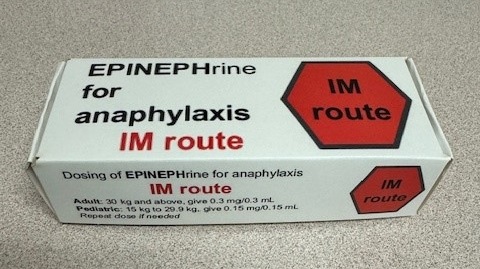Important reminder to our clinical team members tasked with giving medication to patients:
Please be aware that packaging for EPINEPHrine for anaphylaxis has changed.

There is a difference between the dose of EPINEPHrine for anaphylaxis vs. the dose for cardiac arrest. For anaphylaxis, EPINEPHrine is given intramuscularly at a low dose, whereas for cardiac arrest a higher dose is required intravenously – but the dosages can appear to be similar and may be easily mistaken.
As part of our journey as a High Reliability Organization, we strive to be a zero-harm health system. With that in mind, Ballad Health’s pharmacy team has created new packaging for EPINEPHrine for anaphylaxis intended to help team members identify the correct dose and administration.
Here’s what our clinical teams should know
- When administering EPINEPHrine for anaphylaxis, nurses must remember to remove the dose from the Omnicell, where the labeled box is located.
- Nurses must be familiar with the correct indications, dosing and concentration for EPINEPHrine administration. Stop and think: WHY you are giving EPINEPHrine?
- As a memory aid, think: For anaphylaxis, it is given intramuscularly at a low dose, whereas for cardiac arrest, a higher dose is required intravenously.
Details about the new packaging
The new packaging for EPINEPHrine IM for anaphylaxis in Omnicell is a box with labeling indicating IM route and concentration. Each box contains:
- One EPINEPHrine 1 mg/mL vial (1:1,000)
- 2 EpiRite syringes labeled as follows:
- O.1 mL
- 0.15 mL (peds dose 15-29.9 kg)
- 0.3 mL (adult dose 30 kg or more)
- 2 needles/2 alcohol pads







